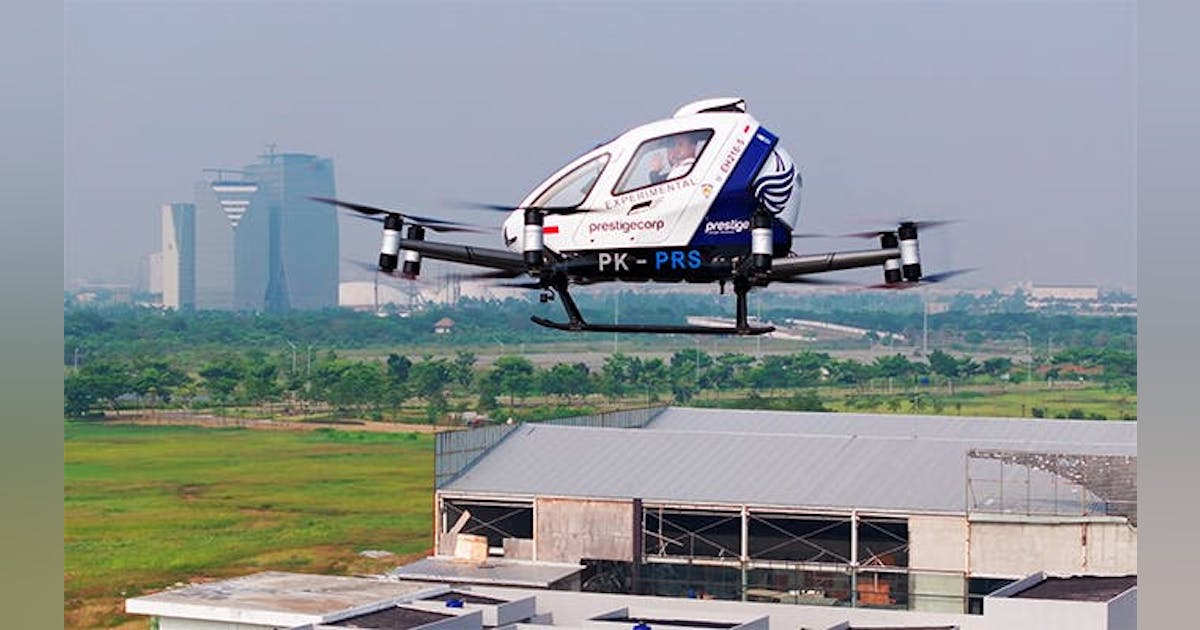EHang’s Passenger-Carrying eVTOL Debuts in Indonesia: A New Era for Urban Air Mobility
The future has made its landing in Indonesia. The Chinese technology firm EHang has celebrated the completion of the first-ever passenger-carrying flights in Indonesia using its autonomous electric vertical takeoff and landing (eVTOL) aircraft, the EH216-S. This event represents a major milestone not only for EHang but also for the global air taxi and urban air mobility industry, marking a significant step forward in self-flying technology and its potential impact on bustling cities worldwide.
What Happened? The First Passenger-Carrying eVTOL Flights in Indonesia
EHang, a leader in the autonomous aerial vehicle (AAV) industry, received special authorization from Indonesia’s Directorate General of Civil Aviation to perform live demonstration flights with the EH216-S eVTOL. These flights were not just technical demonstrations; they transported real passengers, including local aviation officials, business leaders, and international media, with none of them piloting the aircraft.
This event marks Indonesia’s introduction to pilotless air taxis, offering a glimpse into a future where intercity travel could bypass traffic congestion by taking to the skies.
Why Indonesia? A Perfect Testbed for Air Taxis
Indonesia’s geographic layout of over 17,000 islands and its extremely congested cities like Jakarta make it an ideal candidate for air taxis. Conventional transportation methods are often slow and unreliable for short distances between islands or across expansive urban areas.
The eVTOL offers a solution. EHang’s EH216-S can take off and land vertically without a runway, making it suitable for confined spaces and remote locations. The company views Indonesia as an optimal testing ground for new urban travel modes and emergency response strategies.
EH216-S: The Star of the Show
Key Specifications
| Feature | Details |
|---|---|
| Type | eVTOL, autonomous, passenger multicopter |
| Capacity | 2 passengers |
| Max Payload | 220 kg (485 lbs) |
| Cruise Speed | 100 km/h (62 mph) |
| Max Speed | 130 km/h (81 mph) |
| Flight Range | 35 km (22 miles) |
| Max Altitude | 3,000 m (9,843 ft) |
| Flight Time | 21 minutes |
| Power | 16 electric motors, 16 propellers, battery-powered |
| Battery Recharge | 120 minutes |
| Safety | Redundant motors/propellers, advanced sensors |
| Passenger Control | 12-inch touch screen, panoramic windows |
| Features | Gull-wing doors, skid landing gear |
Passengers can enjoy large panoramic windows for sightseeing, with the entire flight autonomously controlled, eliminating the need for a pilot. In case of any partial system failures, the EH216-S can safely continue flying due to its distributed electric propulsion system.
A User Experience Designed for the 21st Century
Imagine booking a ride, stepping into a futuristic cabin, and simply selecting your destination on a 12-inch touch screen. The vehicle conducts a self-check of all systems, plans the safest path, and takes to the skies smoothly. Enjoy a view above the urban chaos while snapping photos of the skyline.
Strategic and Regulatory Context
These Indonesian flights are part of EHang’s broader global strategy. The company previously made history by obtaining the world’s first operator certificates for civil, pilotless passenger-carrying aircraft from Chinese aviation authorities. With these successful demonstrations in Southeast Asia, EHang is working to persuade regulators and the public that eVTOLs are ready for commercial deployment.
“This milestone flight in Indonesia is a key step in advancing our global strategy… We believe this technology can help to alleviate Indonesia’s traffic congestion while offering effective solutions in tourism, sightseeing and emergency rescue.”
— Conor Yang, CFO, EHang
Use Cases That Go Beyond the Buzz
- Urban Transportation: Address traffic issues in Jakarta, Surabaya, or popular tourist areas.
- Tourism and Sightseeing: Deliver new aerial experiences over stunning landscapes and cultural sites.
- Emergency Response: Enable rapid access to disaster zones or isolated areas, overcoming compromised infrastructure.
- Cargo and Medical Supply Delivery: Provide swift, reliable delivery of essential goods across dispersed territories.
Global Implications and Next Steps
Regulatory Hurdles
While the demonstration flights in Indonesia pave the way for ticketed eVTOL services, navigating regulatory requirements is a key step. EHang seeks to obtain similar pilotless operator certificates in Indonesia to initiate commercial operations and begin selling tickets to customers.
Localized Approach
EHang adopts a region-by-region strategy, establishing local operations, training staff, integrating with existing airspace systems, and collaborating with local agencies and tourism boards. This approach helps address logistical hurdles and public acceptance challenges.
A Brief History: From Sci-Fi Dream to Tarmac Reality
For those captivated by futuristic movies like “The Fifth Element” or “Blade Runner,” flying cars seemed like a distant fantasy. However, thanks to advancements in battery technology, autonomy, and lightweight materials, reality is catching up.
EHang’s historic eVTOL flights in Indonesia stemmed from trials as early as 2021, and unlike previous tests involving test weights or engineers, these demonstrations involved real passengers this time.
How Safe Is It? The Tech and Trust Factor
Safety remains crucial for widespread adoption. The EH216-S addresses safety concerns through:
- Autonomous Redundancy: Distributed propulsion allows for safe continued flight in the event of motor or propeller failure.
- Advanced Sensors: Onboard sensors aid in obstacle avoidance, weather navigation, and stability maintenance.
- Central Command Centers: Ground control monitors all flights, providing intervention capabilities during emergencies.
- Short Routes: Initial operations focus on short journeys, minimizing risk and increasing public confidence.
Fast Facts & Fun Stats
- The EH216-S can reach a top speed of 130 km/h (81 mph), covering destinations faster than traditional taxis on highways.
- Each charge allows for a 35 km round trip, ideal for urban commutes or touristic outings.
- The vehicle’s recharge time of 120 minutes ensures efficient utilization and turnaround.
The Bigger Picture: Urban Air Mobility Takes Off
EHang’s Indonesian introduction is a remarkable achievement with broader implications. The urban air mobility (UAM) market is poised for substantial growth, with eVTOLs offering solutions for congested roads, pollution, and slow urban transit.
- Tourism Potential: Indonesia’s Ministry of Tourism is considering eVTOLs for unique aerial tours, including volcano flyovers and VIP resort transfers.
- Business Partnerships: Local airlines and logistics companies are exploring ways to incorporate eVTOLs into existing short-haul networks.
- Public Perception: Each successful flight aids in building familiarity and acceptance, transforming skepticism into convenience.
Meet the Team: EHang’s Human Touch
Behind the advanced technology is a global team of engineers, pilots, and experts. EHang’s outreach includes close collaboration with local aviation authorities, airports, and emergency services. Technical staff who have flown in the EH216-S demonstrate confidence in the technology with their “first flight” stories and selfies.
During live demos, passengers (including Indonesian aviation officials) exited the EH216-S with smiles, some humorously noting it felt “less scary than a Jakarta taxi in rush hour.”
What’s Next? From Demo to Daily Rides
EHang aims to secure commercial operator status in Indonesia, expanding routes and eventually offering ticket sales to the public. Focused on “urban, short-range, high frequency” models, plans include daily commutes, special event shuttles, and tourism packages.
More nations are expected to follow, using Indonesia’s experiences as a reference for safe, systematic autonomous eVTOL implementation.
Conclusion: A Flying Start for Air Taxis in Southeast Asia
EHang’s groundbreaking demonstration in Indonesia is more than a technological showcase. It’s an early glimpse into the solutions cities might employ to manage transport challenges effectively and sustainably.
This development highlights a future where cities like Jakarta might benefit from airborne solutions over conventional road-based systems. Next time you’re caught in Jakarta traffic, remember: soon, your ride might just take to the sky.
The journey is only the beginning. As the air taxi revolution unfolds, the horizon seems limitless!













